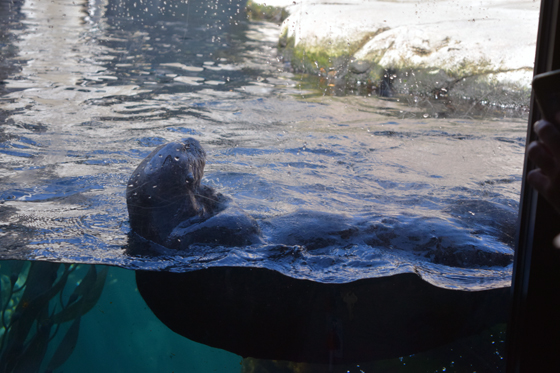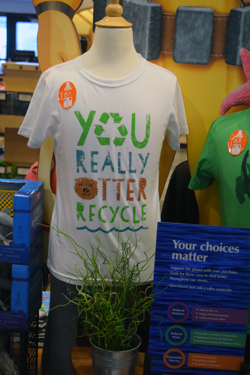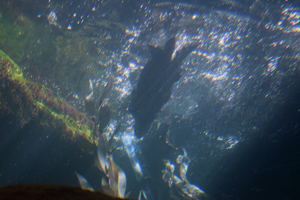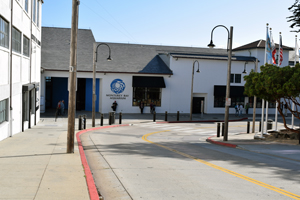
Editor’s Note: From their home in San Diego, co-publishers Don & Nancy Harrison occasionally travel by car to the San Francisco Bay area, where son David and grandchildren Brian and Sara live, and where another grandson, San Diego Jewish World photographer Shor M. Masori, attends UC Berkeley. En route, the Harrisons like to do some sightseeing. This series, which will run on Sundays, tells about some of the places they have visited.
-First in a series-


MONTEREY, California — In Genesis: 1:28 we are taught that God blessed mankind instructing it to, “… rule over the fish of the sea, the bird of the sky, and every living thing that moves on the earth.” At the Monterey Bay Aquarium, a visitor can conclude that the phrase “rule over” is interpreted to mean “do everything in your power to help all living creatures.”
This becomes evident in light of the aquarium’s successful efforts to rescue otters, to teach about conservation, and to instruct children in the fascinating ways of marine life.
In the aquarium’s theater, a power point presentation with slides, videos, and a script is delivered by a young woman named Andrea about the life story of a female otter that personnel at the aquarium had named “Luna.”
When Luna was three days old, she weighed just four pounds. Ordinarily, she would have been dependent on her mother for the next six to eight months “for everything she needed to survive.” This not only included the food that Luna ate, but also three to four hours a day spent by her mother grooming their fur coats, which are otters’ protection against the chilly waters of the Monterey Bay. Unlike seals, sea lions, or walruses, otters do not have blubber to keep them warm.
“On an average day, a sea otter will consume roughly one quarter of its body weight in food,” Andrea told us. “A nursing female, though, will increase that up to about one third of her body weight. That would be like an average human mom consuming up to 25 large pizzas a day.”
Luckily for them, the sea otters have a more varied diet than pizzas. Unrestricted by the laws of kashrut, they dine on invertebrates such as shrimp, crabs, and sea urchins. “Some sea otters eat so many of these purple urchins that they will stain their teeth purple,” according to Andrea. This is a good thing because urchins feed on kelp, and unchecked would destroy the kelp forest which is both a home and a food source for many other species in the Monterey Bay.
When Luna was just a few days old, a major storm over Monterey Bay caused her to become separated from her mother. “By the time the storm was over, Luna was alone. She was tired. She was hungry. And, she cried out for her mom,” Andrea reported.
Someone hearing the cries called the Monterey Bay Aquarium, which sent out Carl, a member of the research team that specializes in otters. After searching the beach and nearby waters unsuccessfully for the mother, Carl decided to bring Luna back to the aquarium to be cared for.

The care involved bottle feeding Luma with formula. The caregivers dressed in a “Darth Vader” outfits to disguise their human identity lest Luna bond with humans and become unfit to return to the wild. When Luna was a bit older, she was put in a pool with an adult female otter, which acted as a foster mother. The older otter taught Luna how to eat a crab and other invertebrates, how to dive down into the waters, and how to forage for food.
Eventually, Luna was old enough to return to the sea, but first she was fitted with a radio transmitter so that the aquarium’s researchers could continue to track her. Carl drove Luna to a beach about 20 miles north of Monterey, where she was released back into the sea. “Luna responded to the wild as if she never left it,” Andrea informed us. Today, Luna is nine years old and has had four pups of her own.
There was a time early in California’s history when otters were freely hunted by fur traders. A little more than a century ago, the population of sea otters off the California coast was estimated to be as few as 50 individuals. Today, with conservation measures in place, “we’re now seeing about 3,200 otters off our coast, still a pretty fragile population,” Andrea said.
Human predators are not the only problems that otters and other creatures of the sea face. A more pressing issue today is pollution.
Not only are cigarettes bad for your health, they also pose great dangers for marine life.
According to a poster on display at the Monterey Bay Aquarium: “Cigarette butts account for 30 percent of all the litter collected at yearly coastal cleanups. Despite what you might think, cigarette filters are made of plastic – not paper or cotton – and take years to break down. In the meantime, the butts leach toxic chemicals into marine habitats and can poison some of the animals that live there.

“Studies also show that ocean wildlife—like birds, dolphins, sea turtles and fishes – swallow cigarette butts and the more than 400 chemicals they contain. Please do your part to keep cigarette butts out of the oceans and other wild places.”
Plastics of all kinds also threaten marine life. “Today, tons of plastic trash swirls on ocean currents,” the aquarium teaches. “To seabirds watching for flashing fishes, shiny plastic debris can look a lot like food. With their bellies full of plastic instead of prey, some seabirds might eventually starve.
“The wind carries plastic cups, bottles, straws and other trash into our waterways and, ultimately, the open sea. How can we help seabirds? Use less plastic –choose reusable bottles and shopping bags.”
Another way in which the Monterey Bay Aquarium stresses conservation is by including sustainable seafood in addition to land-based selections on it’s café’s menu. There are a variety of non-kosher foods offered such as Monterey Bay Dungeness crab and squid, as well as some that are pareve: red dulse seaweed, Ora King salmon and rockfish. The menu also includes various vegetarian options
Educating children to love animals is another method by which the aquarium promotes conservation. By use of push buttons and cranks, the aquarium engages young children’s attention while teaching them about wildlife

behavior. Various exhibits invite the children to “help the pelican dive for dinner,” “help the puffin catch a fish,” “help the gull nab a fish” and “hear the father cormorant call ‘I’m home!’” There also are audio stimulants “Can you hear the father guillemot’s call?” and “Can you hear the puffins clacking their beaks?”
All in all, the Monterey Bay Aquarium is a joy. Admission may seem steep, but the tickets help defray the cost of conservation efforts. Adults: $49.95; Students and Seniors Over 65: $39.95; Children 3-12: $29.95. More information is available via the Monterey Bay Aquarium website.
*
Harrison is editor of San Diego Jewish World. He may be contacted via donald.harrison@sdjewishworld.com